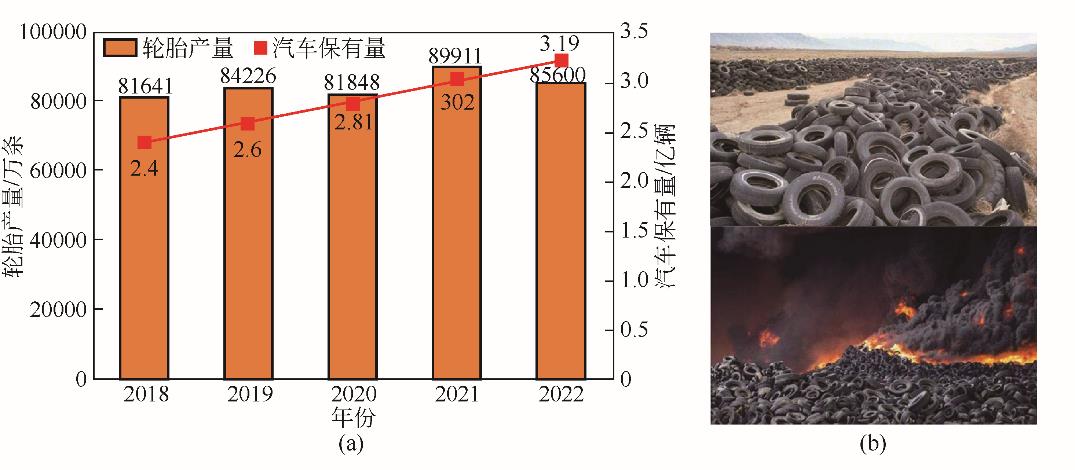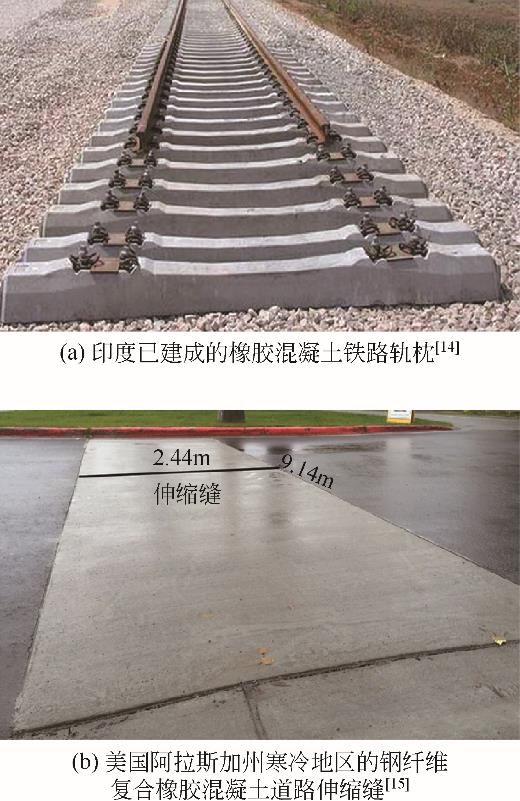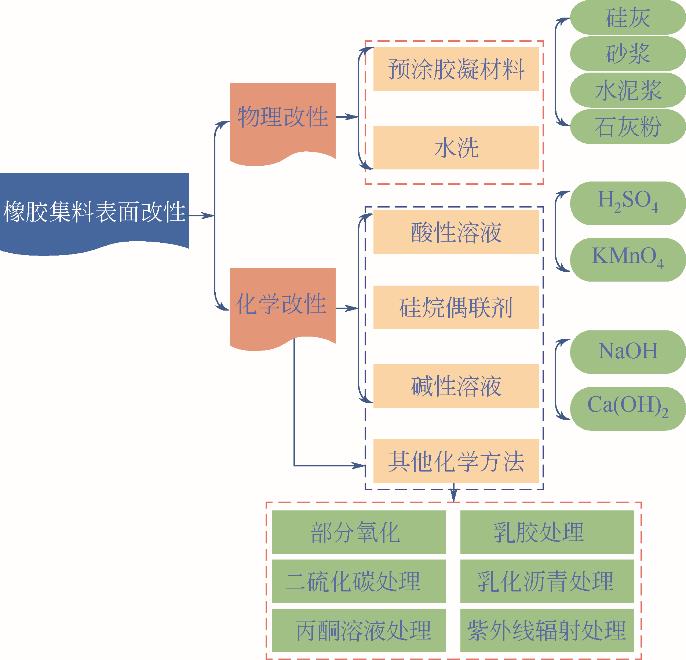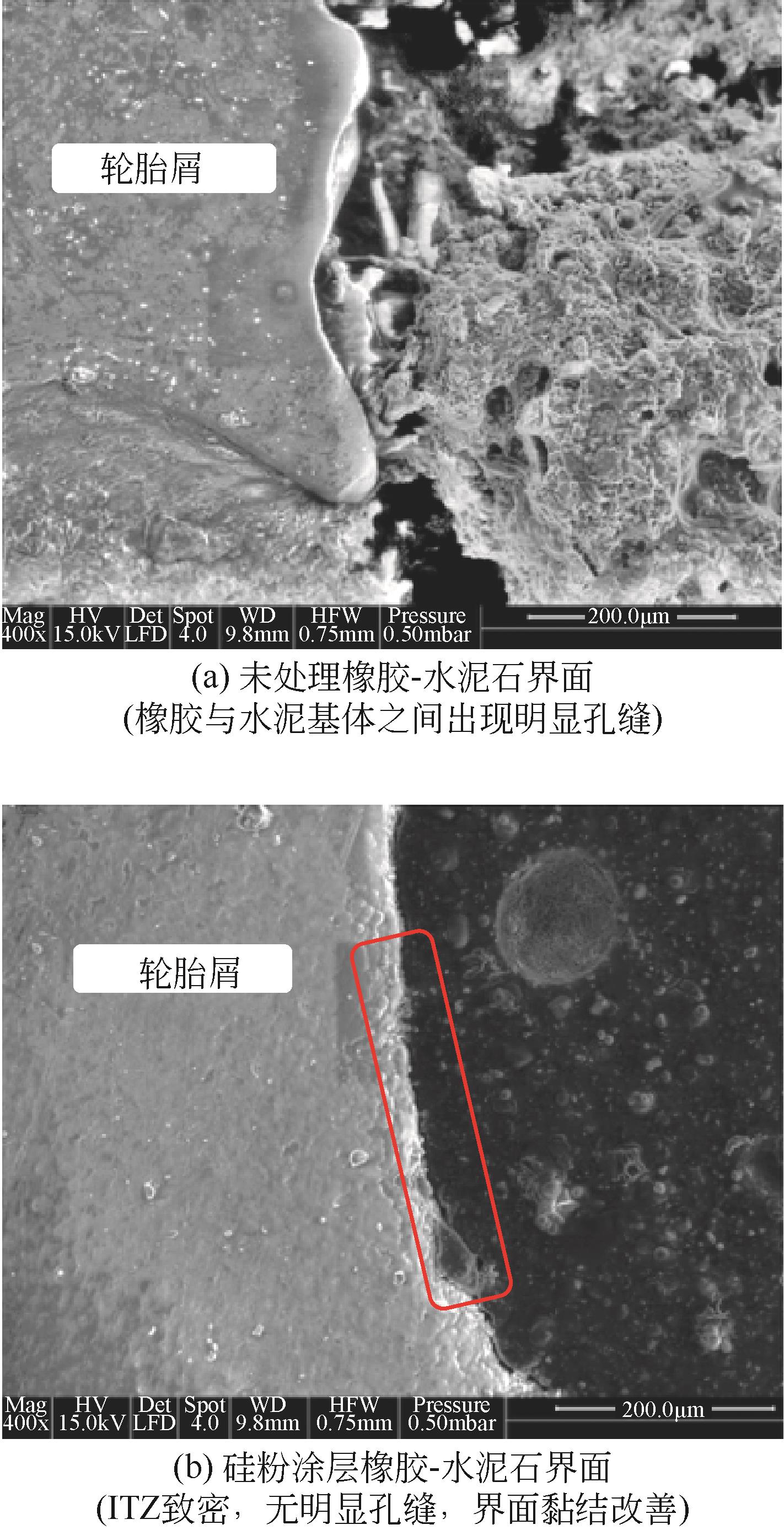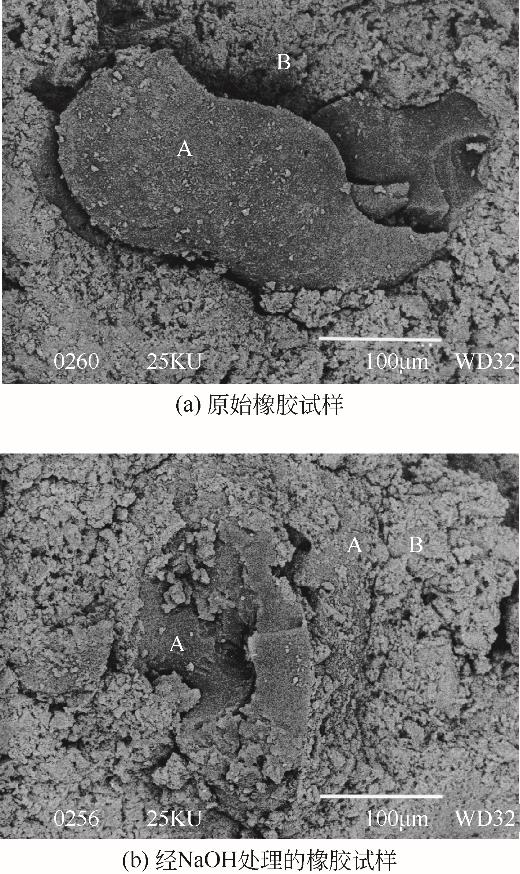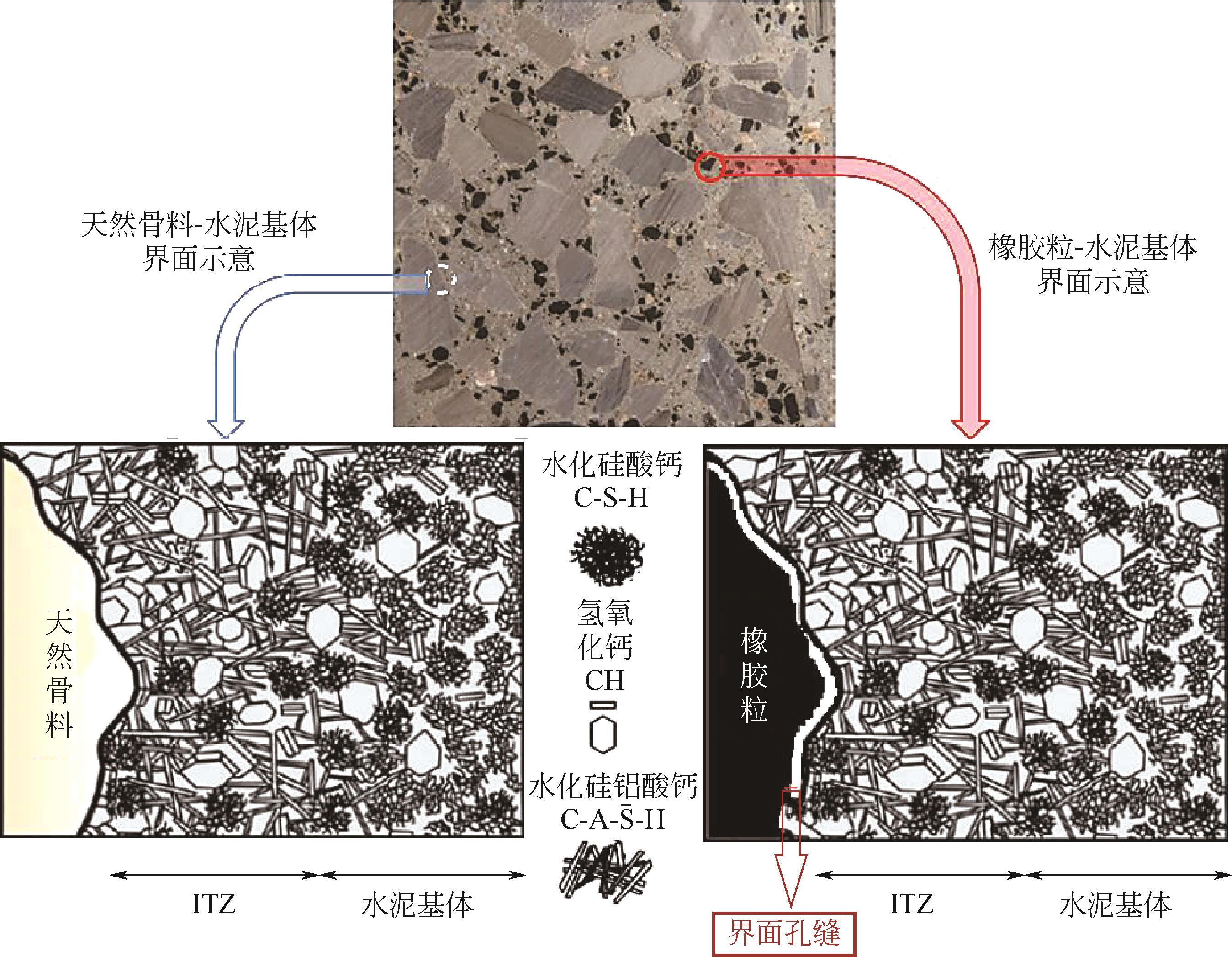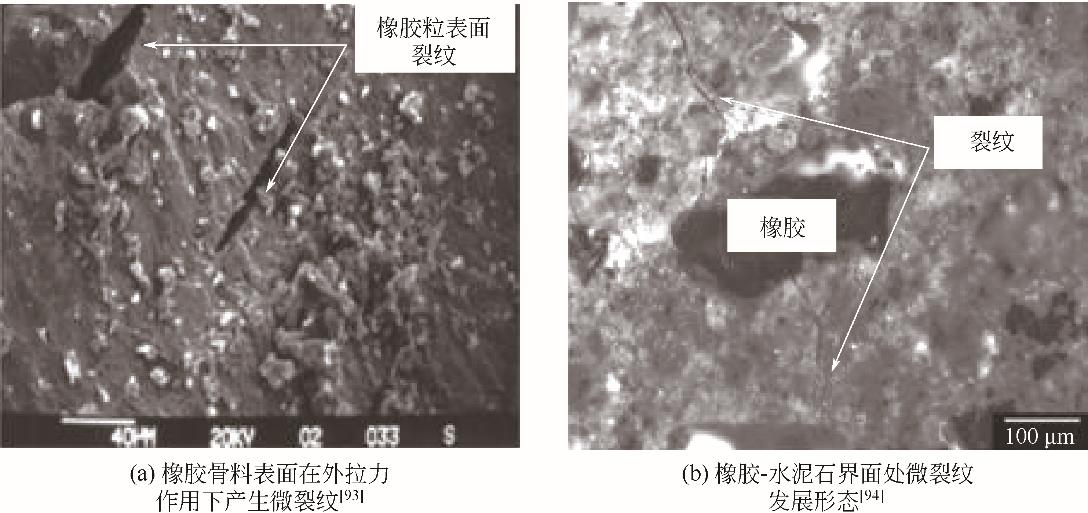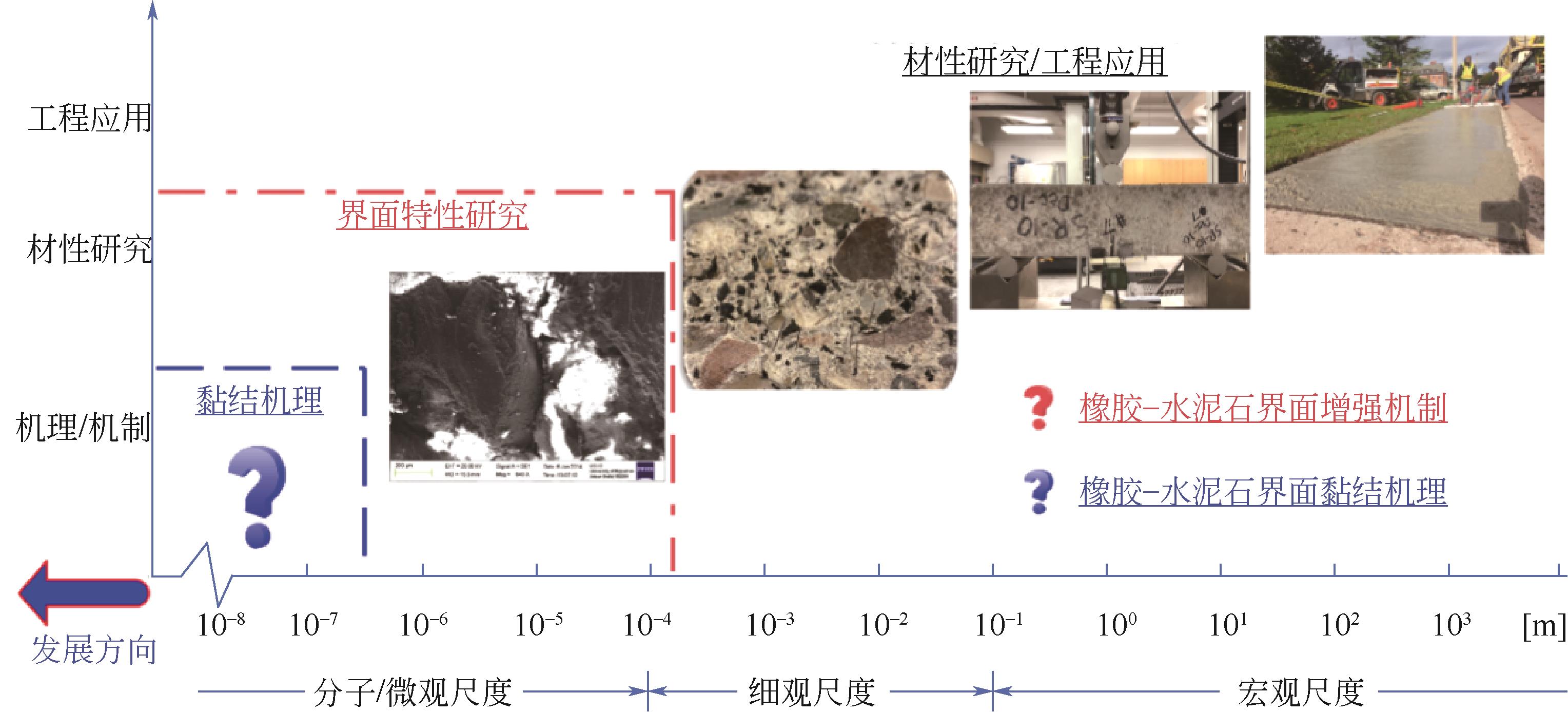化工进展 ›› 2023, Vol. 42 ›› Issue (S1): 328-343.DOI: 10.16085/j.issn.1000-6613.2023-0627
橡胶混凝土界面改性方法及性能提升路径
王家庆1( ), 宋广伟1, 李强1(
), 宋广伟1, 李强1( ), 郭帅成2, DAI Qingli3
), 郭帅成2, DAI Qingli3
- 1.南京林业大学土木工程学院,江苏 南京 210037
2.湖南大学土木工程学院,湖南 长沙 410012
3.美国密歇根理工大学土木与环境工程学院,霍顿 密歇根 49931
-
收稿日期:2023-04-18修回日期:2023-05-29出版日期:2023-10-25发布日期:2023-11-30 -
通讯作者:李强 -
作者简介:王家庆(1994—),男,博士,副教授,主要从事可持续交通基础设施材料与结构的研究。E-mail: jiaqingw@njfu.edu.cn。 -
基金资助:国家自然科学基金(52108408);江苏省基础研究计划自然科学基金(BK20210617);长沙理工大学道路结构与材料交通行业重点实验室开放基金(kjf210303)
Rubber-concrete interface modification method and performance enhancement path
WANG Jiaqing1( ), SONG Guangwei1, LI Qiang1(
), SONG Guangwei1, LI Qiang1( ), GUO Shuaicheng2, DAI Qingli3
), GUO Shuaicheng2, DAI Qingli3
- 1.College of Civil Engineering, Nanjing Forestry University, Nanjing 210037, Jiangsu, China
2.School of Civil Engineering, Hunan University, Changsha 410012, Hunan, China
3.School of Civil and Environmental Engineering, Michigan Technological University, Houghton 49931, Michigan, USA
-
Received:2023-04-18Revised:2023-05-29Online:2023-10-25Published:2023-11-30 -
Contact:LI Qiang
摘要:
废旧轮胎固废作为“黑色污染”给我国生态环境带来巨大压力,将废轮胎回收处理并用作水泥混凝土集料可有效降低环境危害并减少对天然资源的开采;针对橡胶集料与水泥石之间界面性能薄弱的难题,对十余种界面改性方法进行分析,总结不同物理、化学改性方法对界面性能及橡胶混凝土力学性能、耐久性的影响规律。通过纤维增韧路径进一步提升橡胶混凝土材料性能,分析钢纤维、玄武岩纤维、聚丙烯纤维和聚乙烯醇纤维等工程常用纤维材料对橡胶混凝土力学性能及抗裂特性的提升效果;研究发现,界面改性能显著改善橡胶-水泥石脆弱界面,提升界面黏结性能。引入纤维可有效提升橡胶混凝土材料的抗裂特性,其中钢纤维复合橡胶混凝土材料力学强度明显提高,改性橡胶集料和纤维复合技术可起到对水泥混凝土材料的“增韧、抗裂”协同提升作用;现有界面改性技术仍存在较多缺点,其对环境的二次污染和改性效率低的问题有待通过对改性技术的进一步优化而解决。纤维复合橡胶混凝土材料的增韧抗裂特性仍有待更深入的探究,针对两者的协同作用机理的研究将阐明纤维复合橡胶混凝土材料的性能优势,可为实际工程应用提供有效的科学依据,进一步扩大废轮胎固废在水泥混凝土材料中的“高值化”利用规模。
中图分类号:
引用本文
王家庆, 宋广伟, 李强, 郭帅成, DAI Qingli. 橡胶混凝土界面改性方法及性能提升路径[J]. 化工进展, 2023, 42(S1): 328-343.
WANG Jiaqing, SONG Guangwei, LI Qiang, GUO Shuaicheng, DAI Qingli. Rubber-concrete interface modification method and performance enhancement path[J]. Chemical Industry and Engineering Progress, 2023, 42(S1): 328-343.
| 界面改性方法 | 优点 | 缺点 | 作用机理 | 参考文献 |
|---|---|---|---|---|
| 物理改性 | ||||
| 水洗 | 成本低,环保 | 效果不明显 | 清洗表面杂质,橡胶表面亲水 | [ |
| 预涂胶凝材料 | 材料易得,改性效果较好 | 预涂工艺,复杂耗时 | 提高橡胶集料的弹性模量,橡胶表面亲水 | [ |
| 化学改性 | ||||
| H2SO4 | 改性效果较好 | 处理复杂耗时 | 去除杂质,橡胶表面亲水 | [ |
| KMnO4 | 改性效果较好 | 处理复杂耗时 | 去除杂质,橡胶表面亲水 | [ |
| 硅烷偶联剂 | 改性效果较好 | 危害环境 | 橡胶和水泥基体间形成化学键,橡胶表面亲水 | [ |
| NaOH | 改性效果好,应用广泛 | 处理复杂耗时 | 去除硬脂酸锌和其他杂质,橡胶表面亲水 | [ |
| Ca(OH)2 | 成本低 | 应用不广泛 | 去除杂质,橡胶表面亲水 | [ |
| 部分氧化 | 成本低 | 危害环境,应用不广泛 | 橡胶表面亲水 | [ |
| 胶乳改性 | 改性效果较好,操作方便 | 成本较高 | 促进橡胶与基体之间的黏合、填充效果好 | [ |
| 二硫化碳处理 | 成本低,节省材料 | 有毒 | 橡胶表面亲水,促进水泥水化 | [ |
| 乳化沥青处理 | 改性效果好,经济 | 处理复杂,应用不广泛 | 促进橡胶与基体之间黏合 | [ |
| 丙酮溶液 | 改性效果较好,操作方便 | 有毒,应用不广泛 | 橡胶表面亲水 | [ |
| 紫外线辐射 | 成本低,清洁 | 应用不广泛 | 橡胶表面亲水 | [ |
表1 橡胶混凝土界面改性方法对比分析[27]
| 界面改性方法 | 优点 | 缺点 | 作用机理 | 参考文献 |
|---|---|---|---|---|
| 物理改性 | ||||
| 水洗 | 成本低,环保 | 效果不明显 | 清洗表面杂质,橡胶表面亲水 | [ |
| 预涂胶凝材料 | 材料易得,改性效果较好 | 预涂工艺,复杂耗时 | 提高橡胶集料的弹性模量,橡胶表面亲水 | [ |
| 化学改性 | ||||
| H2SO4 | 改性效果较好 | 处理复杂耗时 | 去除杂质,橡胶表面亲水 | [ |
| KMnO4 | 改性效果较好 | 处理复杂耗时 | 去除杂质,橡胶表面亲水 | [ |
| 硅烷偶联剂 | 改性效果较好 | 危害环境 | 橡胶和水泥基体间形成化学键,橡胶表面亲水 | [ |
| NaOH | 改性效果好,应用广泛 | 处理复杂耗时 | 去除硬脂酸锌和其他杂质,橡胶表面亲水 | [ |
| Ca(OH)2 | 成本低 | 应用不广泛 | 去除杂质,橡胶表面亲水 | [ |
| 部分氧化 | 成本低 | 危害环境,应用不广泛 | 橡胶表面亲水 | [ |
| 胶乳改性 | 改性效果较好,操作方便 | 成本较高 | 促进橡胶与基体之间的黏合、填充效果好 | [ |
| 二硫化碳处理 | 成本低,节省材料 | 有毒 | 橡胶表面亲水,促进水泥水化 | [ |
| 乳化沥青处理 | 改性效果好,经济 | 处理复杂,应用不广泛 | 促进橡胶与基体之间黏合 | [ |
| 丙酮溶液 | 改性效果较好,操作方便 | 有毒,应用不广泛 | 橡胶表面亲水 | [ |
| 紫外线辐射 | 成本低,清洁 | 应用不广泛 | 橡胶表面亲水 | [ |
纤维 种类 | 橡胶 替代率 | 纤维 体积率/体积掺量 | 抗压强度 变化 | 劈裂抗拉 强度变化 | 抗弯强度 变化 | 其他性能 | 参考文献 |
|---|---|---|---|---|---|---|---|
| 钢纤维 | 5%,10%,15% | 0.5%,0.75%,1% | 掺量<0.75% 有一定提高 | 随纤维掺量增加 提高8% | 随纤维掺量增加 提高60% | 弹性模量随钢纤维掺量增加而提高 | [ |
| 0,5%,10%,15% | 0,0.5%,1%,1.5% | 0.5%纤维 增长幅度最大 | 1%纤维 提高28% | — | 10%橡胶+1%钢纤维协同作用较好 | [ | |
| 5% | 1%,1.5%,2% | 层布式降低 全掺式稳定 | 层布式稳定 全掺式提高 | 层布式提高 全掺式提高 | 体积率不超过1.5%优选层布式 体积率为2%采用全掺式 | [ | |
| 0,10%,20% | 0,0.25%,0.5%,1% | — | — | — | 纤维用量0~1%时,初始裂纹和最终破坏的抗冲击性分别提高了2.90倍和5.09倍 | [ | |
| 0~35% | 0,0.35%,1% | — | — | — | 抗剪强度提高,缩小裂纹 | [ | |
| 10%,20% | 0.5%,1% | — | — | 随纤维掺量增加提高 | 密度和吸收率略有增加,韧性和耐磨性也显著提高,不影响抗滑性 | [ | |
| 5% | 0,0.5%,1%,1.5% | — | — | — | 提高韧性,初始黏结强度、极限黏结强度等随纤维体积率增加先增大后降低 | [ | |
| 10% | 0,1%,1.5%,2% | 2%纤维 提高26.6% | — | 随纤维掺量增加提高 | 钢纤维对质量损失率的影响为正,对相对动态弹性模量的影响为负 | [ | |
| 5%,10% | 1%,1.5% | 提高 | — | — | 纤维与橡胶取代率的增加导致强度对应的轴向应变和侧向应变的增加 | [ | |
| 10%,15%,25% | 0.2% | — | — | 提高 | 纤维与橡胶结合对提高混凝土的裂纹扩展和耗能具有积极的耦合作用 | [ | |
| 聚乙烯醇纤维 | 15%,20%,25% | 0.5% | 略有降低 | — | 提高 | 改善力学性能,提高断裂能 良好的冻融性能和长期耐久性 | [ |
| 4%,8%,12%,16% | 0.1%,0.3%,0.5%,0.7% | — | — | — | 12%橡胶、0.1%纤维、温度20℃时抗渗性最好 | [ | |
| 5%,10%,15%,20% | 2.4kg/m³ | 28天 强度提高 | — | 降低 | 提高阻尼率,但加剧其界面缺陷 | [ | |
| 5%,10%,15% | 0.1%,0.2%,0.3% | 提高 | 提高 | 提高 | 玄武岩纤维和PVA纤维复合提高了强度 | [ | |
| 10%,20%,30% | 0.1%,0.2%,0.3% | 略有提高 | 提高 | 提高 | 混杂纤维复合对混凝土的劈裂抗拉强度和弯曲强度有积极的影响 | [ | |
| 玄武岩纤维 | 10% | 0.05%,0.1%,0.15%,0.2% | 随纤维掺量增加提高 | — | 随纤维掺量增加提高 | 纤维掺量为0.2%时混凝土强度最大 | [ |
| 5%~30% | 1~5kg/m³ | 1~3kg/m³ 强度提高 | — | — | 提高试件整体性和抗压强度,提高抗冻性能 | [ | |
| 15% | 0.08%,0.10%,0.12% | 0.1%纤维 强度提升最佳 | — | — | 纤维进一步提高抗冲击性能 | [ | |
| 10% | 2kg/m³,4kg/m³ | — | 提高 | 提高 | 较好的强度和变形性能,增韧效果明显 | [ | |
| 0~1% | 0.1% | 提高 | 提高 | — | 提高干缩性和抗冻性 | [ | |
| 10% | 4.56kg/m³ | — | — | 提高 | 提高工作性能 | [ | |
| 聚丙烯纤维 | 2%,6%,10% | 0.1%,0.5%,0.9% | 降低 | 先提高 后降低 | 降低 | 改善韧性,纤维掺量0.5%内最佳 | [ |
| 20% | 0.6kg/m³,1.2kg/m³ | 1.2kg/m³ 提升11.7% | 1.2kg/m³ 提升13.4% | 1.2kg/m³ 提升19.4% | 1.2kg/m³弹性模量提升15.5% | [ | |
| 5%,10% | 1%,2% | 提高 | 提高 | 提高 | 韧性和延性随纤维增加而提升 | [ | |
3%,6%, 9%,12% | 0.1%,0.2%,0.3% | 纤维增加 强度提高 | 略有提高 | 略有提高 | 密度略有提高 | [ |
表2 不同纤维增强橡胶混凝土性能影响规律
纤维 种类 | 橡胶 替代率 | 纤维 体积率/体积掺量 | 抗压强度 变化 | 劈裂抗拉 强度变化 | 抗弯强度 变化 | 其他性能 | 参考文献 |
|---|---|---|---|---|---|---|---|
| 钢纤维 | 5%,10%,15% | 0.5%,0.75%,1% | 掺量<0.75% 有一定提高 | 随纤维掺量增加 提高8% | 随纤维掺量增加 提高60% | 弹性模量随钢纤维掺量增加而提高 | [ |
| 0,5%,10%,15% | 0,0.5%,1%,1.5% | 0.5%纤维 增长幅度最大 | 1%纤维 提高28% | — | 10%橡胶+1%钢纤维协同作用较好 | [ | |
| 5% | 1%,1.5%,2% | 层布式降低 全掺式稳定 | 层布式稳定 全掺式提高 | 层布式提高 全掺式提高 | 体积率不超过1.5%优选层布式 体积率为2%采用全掺式 | [ | |
| 0,10%,20% | 0,0.25%,0.5%,1% | — | — | — | 纤维用量0~1%时,初始裂纹和最终破坏的抗冲击性分别提高了2.90倍和5.09倍 | [ | |
| 0~35% | 0,0.35%,1% | — | — | — | 抗剪强度提高,缩小裂纹 | [ | |
| 10%,20% | 0.5%,1% | — | — | 随纤维掺量增加提高 | 密度和吸收率略有增加,韧性和耐磨性也显著提高,不影响抗滑性 | [ | |
| 5% | 0,0.5%,1%,1.5% | — | — | — | 提高韧性,初始黏结强度、极限黏结强度等随纤维体积率增加先增大后降低 | [ | |
| 10% | 0,1%,1.5%,2% | 2%纤维 提高26.6% | — | 随纤维掺量增加提高 | 钢纤维对质量损失率的影响为正,对相对动态弹性模量的影响为负 | [ | |
| 5%,10% | 1%,1.5% | 提高 | — | — | 纤维与橡胶取代率的增加导致强度对应的轴向应变和侧向应变的增加 | [ | |
| 10%,15%,25% | 0.2% | — | — | 提高 | 纤维与橡胶结合对提高混凝土的裂纹扩展和耗能具有积极的耦合作用 | [ | |
| 聚乙烯醇纤维 | 15%,20%,25% | 0.5% | 略有降低 | — | 提高 | 改善力学性能,提高断裂能 良好的冻融性能和长期耐久性 | [ |
| 4%,8%,12%,16% | 0.1%,0.3%,0.5%,0.7% | — | — | — | 12%橡胶、0.1%纤维、温度20℃时抗渗性最好 | [ | |
| 5%,10%,15%,20% | 2.4kg/m³ | 28天 强度提高 | — | 降低 | 提高阻尼率,但加剧其界面缺陷 | [ | |
| 5%,10%,15% | 0.1%,0.2%,0.3% | 提高 | 提高 | 提高 | 玄武岩纤维和PVA纤维复合提高了强度 | [ | |
| 10%,20%,30% | 0.1%,0.2%,0.3% | 略有提高 | 提高 | 提高 | 混杂纤维复合对混凝土的劈裂抗拉强度和弯曲强度有积极的影响 | [ | |
| 玄武岩纤维 | 10% | 0.05%,0.1%,0.15%,0.2% | 随纤维掺量增加提高 | — | 随纤维掺量增加提高 | 纤维掺量为0.2%时混凝土强度最大 | [ |
| 5%~30% | 1~5kg/m³ | 1~3kg/m³ 强度提高 | — | — | 提高试件整体性和抗压强度,提高抗冻性能 | [ | |
| 15% | 0.08%,0.10%,0.12% | 0.1%纤维 强度提升最佳 | — | — | 纤维进一步提高抗冲击性能 | [ | |
| 10% | 2kg/m³,4kg/m³ | — | 提高 | 提高 | 较好的强度和变形性能,增韧效果明显 | [ | |
| 0~1% | 0.1% | 提高 | 提高 | — | 提高干缩性和抗冻性 | [ | |
| 10% | 4.56kg/m³ | — | — | 提高 | 提高工作性能 | [ | |
| 聚丙烯纤维 | 2%,6%,10% | 0.1%,0.5%,0.9% | 降低 | 先提高 后降低 | 降低 | 改善韧性,纤维掺量0.5%内最佳 | [ |
| 20% | 0.6kg/m³,1.2kg/m³ | 1.2kg/m³ 提升11.7% | 1.2kg/m³ 提升13.4% | 1.2kg/m³ 提升19.4% | 1.2kg/m³弹性模量提升15.5% | [ | |
| 5%,10% | 1%,2% | 提高 | 提高 | 提高 | 韧性和延性随纤维增加而提升 | [ | |
3%,6%, 9%,12% | 0.1%,0.2%,0.3% | 纤维增加 强度提高 | 略有提高 | 略有提高 | 密度略有提高 | [ |
| 1 | 吴志红. “十四五”废旧轮胎综合利用开启“绿色黄金”时代[J]. 中国轮胎资源综合利用, 2021(5): 10-12. |
| WU Zhihong. The comprehensive utilization of waste tires in the 14th Five-Year Plan period opens the era of “Green Gold”[J]. China Tire Resources Recycling, 2021(5): 10-12. | |
| 2 | 《中国公路学报》编辑部. 中国路面工程学术研究综述·2020[J]. 中国公路学报, 2020, 33(10): 1-66. |
| Editorial Department of China Journal of Highway and Transport. Review on China’s pavement engineering Research·2020[J]. China Journal of Highway and Transport, 2020, 33(10): 1-66. | |
| 3 | 朱宝忠, 程功, 汪玉, 等. 中国废轮胎回收利用现状综述[J]. 广州化工, 2014, 42(9): 11-12, 27. |
| ZHU Baozhong, CHENG Gong, WANG Yu, et al. Review of recycling utilization for waste tire in China[J]. Guangzhou Chemical Industry, 2014, 42(9): 11-12, 27. | |
| 4 | 张兴. 废轮胎资源化利用现状及发展趋势[J]. 山东化工, 2019, 48(14): 105, 108. |
| ZHANG Xing. Present situation and development trend of resource utilization of waste tires[J]. Shandong Chemical Industry, 2019, 48(14): 105, 108. | |
| 5 | SIMIC Vladimir, Svetlana DABIC-OSTOJIC. Interval-parameter chance-constrained programming model for uncertainty-based decision making in tire retreading industry[J]. Journal of Cleaner Production, 2017, 167: 1490-1498. |
| 6 | 葛梦媛. 废旧轮胎行业碳核查技术及碳减排项目开发研究[D]. 天津: 河北工业大学, 2017. |
| GE Mengyuan. Research on MRV methodology and ccer methodology for resourced re-utilization of watsed tyre[D]. Tianjin: Hebei University of Technology, 2017. | |
| 7 | 林火灿. 废旧轮胎翻修与循环利用发展前景广阔[N]. 经济日报, 2011-02-25(10). |
| 8 | 苏瑞景, 关杰, 梁波. 废轮胎资源化利用现状[J]. 上海第二工业大学学报, 2016, 33(1): 20-26. |
| SU Ruijing, GUAN Jie, LIANG Bo. Research progress in recycling of waste tyre[J]. Journal of Shanghai Second Polytechnic University, 2016, 33(1): 20-26. | |
| 9 | WANG Zefeng, KANG Yong, WANG Zhao, et al. Recycling waste tire rubber by water jet pulverization: Powder characteristics and reinforcing performance in natural rubber composites[J]. Journal of Polymer Engineering, 2018, 38(1): 51-62. |
| 10 | CHEN Ruiyu, LI Quanwei, ZHANG Yang, et al. Pyrolysis kinetics and mechanism of typical industrial non-tyre rubber wastes by peak-differentiating analysis and multi kinetics methods[J]. Fuel, 2019, 235: 1224-1237. |
| 11 | LIU Hanbing, WANG Xianqiang, JIAO Yubo, et al. Experimental investigation of the mechanical and durability properties of crumb rubber concrete[J]. Materials, 2016, 9(3): 172. |
| 12 | 邓宗才, 刘希成. 路用橡胶混凝土的研究现状分析与展望[J]. 国防交通工程与技术, 2010, 8(6): 1-5. |
| DENG Zongcai, LIU Xicheng. Analysis of the present and future development of rubberized concrete in highway engineering[J]. Traffic Engineering and Technology for National Defence, 2010, 8(6): 1-5. | |
| 13 | ALBANO C, CAMACHO N, REYES J, et al. Influence of scrap rubber addition to Portland I concrete composites: Destructive and non-destructive testing[J]. Composite Structures, 2005, 71(3/4): 439-446. |
| 14 | HAMEED Afia S, SHASHIKALA A P. Suitability of rubber concrete for railway sleepers[J]. Perspectives in Science, 2016, 8: 32-35. |
| 15 | ABAZA Osama A, ABOUEID Mahear A. Use of steel fiber–reinforced rubberized concrete for roadway intersections in cold regions: Alaska[J]. Journal of Transportation Engineering, Part B: Pavements, 2018, 144(4): 04018048. |
| 16 | 亢景付, 任海波, 张平祖. 橡胶混凝土的抗裂性能和弯曲变形性能[J]. 复合材料学报, 2006, 23(6): 158-162. |
| KANG Jingfu, REN Haibo, ZHANG Pingzu. Cracking-resistance and flexural property of rubberized concrete[J]. Acta Materiae Compositae Sinica, 2006, 23(6): 158-162. | |
| 17 | LIU Feng, ZHENG Wanhu, LI Lijuan, et al. Mechanical and fatigue performance of rubber concrete[J]. Construction and Building Materials, 2013, 47: 711-719. |
| 18 | 王龙, 范璐璐. 橡胶颗粒水泥混凝土与基质混凝土路用性能对比分析[J]. 哈尔滨工业大学学报, 2016, 48(3): 77-81. |
| WANG Long, FAN Lulu. Analysis of road performance between rub-concrete and general concrete materials[J]. Journal of Harbin Institute of Technology, 2016, 48(3): 77-81. | |
| 19 | WANG Jiaqing, DAI Qingli, SI Ruizhe, et al. Mechanical, durability, and microstructural properties of macro synthetic polypropylene (PP) fiber-reinforced rubber concrete[J]. Journal of Cleaner Production, 2019, 234: 1351-1364. |
| 20 | 陈卓明. 橡胶混凝土界面性能的研究[D]. 广州: 广东工业大学, 2019. |
| CHEN Zhuoming. Research on interfacial properties of rubberized concrete[D]. Guangzhou: Guangdong University of Technology, 2019. | |
| 21 | KHATIB Z, BAYOMY F. Rubberized Portland cement concrete[J]. Journal of Materials in Civil Engineering, 1999, 11: 206-213. |
| 22 | KHATIB Zaher K, BAYOMY Fouad M. Rubberized Portland cement concrete[J]. Journal of Materials in Civil Engineering, 1999, 11(3): 206-213. |
| 23 | TOPÇU Ilker Bekir. The properties of rubberized concretes[J]. Cement and Concrete Research, 1995, 25(2): 304-310. |
| 24 | 李艳茹, 朱涵, 刘春生. 机场道面橡胶集料混凝土弯曲性能试验及应用[J]. 解放军理工大学学报(自然科学版), 2011, 12(4): 367-371. |
| LI Yanru, ZHU Han, LIU Chunsheng. Application and test of crumb rubber concrete in airport pavement[J]. Journal of PLA University of Science and Technology (Natural Science Edition), 2011, 12(4): 367-371. | |
| 25 | ABDELALEEM Basem H, HASSAN Assem A A. Development of self-consolidating rubberized concrete incorporating silica fume[J]. Construction and Building Materials, 2018, 161: 389-397. |
| 26 | 姚韦靖, 刘雨姗, 王婷雅, 等. 橡胶/混凝土盐冻循环后性能劣化及微观结构[J]. 复合材料学报, 2021, 38(12): 4294-4304. |
| YAO Weijing, LIU Yushan, WANG Tingya, et al. Performance degradation and microscopic structure of rubber/concrete after salt freeze-thaw cycles[J]. Acta Materiae Compositae Sinica, 2021, 38(12): 4294-4304. | |
| 27 | LI Yang, ZHANG Xu, WANG Ruijun, et al. Performance enhancement of rubberised concrete via surface modification of rubber: A review[J]. Construction and Building Materials, 2019, 227: 116691. |
| 28 | RICHARDSON Alan E, COVENTRY Kathryn A, WARD Gavin. Freeze/thaw protection of concrete with optimum rubber crumb content[J]. Journal of Cleaner Production, 2012, 23(1): 96-103. |
| 29 | YOUSSF Osama, HASSANLI Reza, MILLS Julie E, et al. An experimental investigation of the mechanical performance and structural application of LECA-Rubcrete[J]. Construction and Building Materials, 2018, 175: 239-253. |
| 30 | 段展鹏. 改性橡胶集料水泥基材料性能及微观机理试验研究[D]. 武汉: 湖北工业大学, 2020. |
| DUAN Zhanpeng. Experimental study on properties and micromechanism of modified rubber aggregate cement-based materials[D]. Wuhan: Hubei University of Technology, 2020. | |
| 31 | MOHAMMADI Iman, KHABBAZ Hadi, VESSALAS Kirk. In-depth assessment of Crumb Rubber Concrete (CRC) prepared by water-soaking treatment method for rigid pavements[J]. Construction and Building Materials, 2014, 71: 456-471. |
| 32 | GUO Shuaicheng, DAI Qingli, SI Ruizhe, et al. Evaluation of properties and performance of rubber-modified concrete for recycling of waste scrap tire[J]. Journal of Cleaner Production, 2017, 148: 681-689. |
| 33 | KASHANI Alireza, Tuan Duc NGO, HEMACHANDRA Prashastha, et al. Effects of surface treatments of recycled tyre crumb on cement-rubber bonding in concrete composite foam[J]. Construction and Building Materials, 2018, 171: 467-473. |
| 34 | Khalid Battal Najim, Matthew Robert Hall. Crumb rubber aggregate coatings/pre-treatments and their effects on interfacial bonding, air entrapment and fracture toughness in self-compacting rubberised concrete (SCRC)[J]. Materials and Structures, 2013, 46(12): 2029-2043. |
| 35 | ONUAGULUCHI Obinna. Effects of surface pre-coating and silica fume on crumb rubber-cement matrix interface and cement mortar properties[J]. Journal of Cleaner Production, 2015, 104: 339-345. |
| 36 | 于娇. 基于分子动力学的硅烷偶联剂改性橡胶水泥基材料设计与性能研究[D]. 青岛: 青岛理工大学, 2021. |
| YU Jiao. Design and performance study of silane coupling agent modified rubber cement-based material based on molecular dynamics[D]. Qingdao: Qingdao Tehcnology University, 2021. | |
| 37 | Belén MUÑOZ-SÁNCHEZ, ARÉVALO-CABALLERO María José, PACHECO-MENOR María Concepción. Influence of acetic acid and calcium hydroxide treatments of rubber waste on the properties of rubberized mortars[J]. Materials and Structures, 2017, 50(1): 75. |
| 38 | HE Liang, MA Yu, LIU Quantao, et al. Surface modification of crumb rubber and its influence on the mechanical properties of rubber-cement concrete[J]. Construction and Building Materials, 2016, 120: 403-407. |
| 39 | LEUNG Chin K, GRASLEY Zachary C. Effect of micrometric and nanometric viscoelastic inclusions on mechanical damping behavior of cementitious composites[J]. Construction and Building Materials, 2012, 35: 444-451. |
| 40 | ZHANG Haibo, GOU Mifeng, LIU Xiaoxing, et al. Effect of rubber particle modification on properties of rubberized concrete[J]. Journal of Wuhan University of Technology: Mater. Sci. Ed., 2014, 29(4): 763-768. |
| 41 | 杨长辉, 田义, 王磊, 等. NaOH预处理对橡胶混凝土性能的影响[J]. 土木建筑与环境工程, 2016, 38(2): 44-50. |
| YANG Changhui, TIAN Yi, WANG Lei, et al. Influence of NaOH Pretreatments on the properties of rubber concrete[J]. Journal of Civil, Architectural & Environmental Engineering, 2016, 38(2): 44-50. | |
| 42 | SEGRE N, JOEKES I. Use of tire rubber particles as addition to cement paste[J]. Cement and Concrete Research, 2000, 30(9): 1421-1425. |
| 43 | PELISSER Fernando, ZAVARISE Nilomar, LONGO Tiago Arent, et al. Concrete made with recycled tire rubber: Effect of alkaline activation and silica fume addition[J]. Journal of Cleaner Production, 2011, 19(6/7): 757-763. |
| 44 | Belén MUÑOZ-SÁNCHE Z, ARÉVALO-CABALLERO María José, PACHECO-MENOR María Concepción. Influence of acetic acid and calcium hydroxide treatments of rubber waste on the properties of rubberized mortars[J]. Materials and Structures, 2017, 50(1): 75. |
| 45 | DONG Qiao, HUANG Baoshan, SHU Xiang. Rubber modified concrete improved by chemically active coating and silane coupling agent[J]. Construction and Building Materials, 2013, 48: 116-123. |
| 46 | LI Gengying, WANG Zhongkun, LEUNG Christopher K Y, et al. Properties of rubberized concrete modified by using silane coupling agent and carboxylated SBR[J]. Journal of Cleaner Production, 2016, 112: 797-807. |
| 47 | Emam E, Yehia S. Experimental study on enhanced crumb rubber concrete[J]. International Journal of Scientific and Engineering Research, 2018, 9(2): 1240-1247. |
| 48 | CHEN Bing, LIU Ning. Experimental research on properties of fresh and hardened rubberized concrete[J]. Journal of Materials in Civil Engineering, 2014, 26(8): 04014040. |
| 49 | RIVAS-VÁZQUEZ L P, SUÁREZ-ORDUÑA R, HERNÁNDEZ-TORRES J, et al. Effect of the surface treatment of recycled rubber on the mechanical strength of composite concrete/rubber[J]. Materials and Structures, 2015, 48(9): 2809-2814. |
| 50 | CHEN Zhuoming, LI Lijuan, XIONG Zhe. Investigation on the interfacial behaviour between the rubber-cement matrix of the rubberized concrete[J]. Journal of Cleaner Production, 2019, 209: 1354-1364. |
| 51 | CHOU Liang-Hsing, YANG Cho-Kun, LEE Maw-Tien, et al. Effects of partial oxidation of crumb rubber on properties of rubberized mortar[J]. Composites Part B: Engineering, 2010, 41(8): 613-616. |
| 52 | CHEN Chiyao, LEE Maw-Tien. Application of crumb rubber in cement-matrix composite[J]. Materials, 2019, 12(3): 529. |
| 53 | OSSOLA Gregorio, WOJCIK Adam. UV modification of tire rubber for use in cementitious composites[J]. Cement and Concrete Composites, 2014, 52: 34-41. |
| 54 | 张琴. 纤维橡胶混凝土力学特性试验研究[D]. 淮南: 安徽理工大学, 2020. |
| ZHANG Qin. Experimental study on mechanical properties of fiber rubber concrete[D]. Huainan: Anhui University of Science & Technology, 2020. | |
| 55 | 王彬. 冻融循环下钢纤维改性橡胶混凝土的力学性能及细观机理研究[D]. 西安: 西京学院, 2021. |
| WANG Bin. Study on mechanical properties and meso mechanism of steel fiber modified rubber concrete under freeze-thaw cycle[D]. Xi'an: Xijing University, 2021. | |
| 56 | 付传清, 颜扬, 张耿耿, 等. 钢纤维改性橡胶混凝土基本力学性能研究[J]. 混凝土, 2016(11): 144-148. |
| FU Chuanqing, YAN Yang, ZHANG Genggeng, et al. Experimental study on mechanical properties of steel fiber modified rubber concrete[J]. Concrete, 2016(11): 144-148. | |
| 57 | 赵修敏, 杨海峰, 李雪良, 等. 钢纤维橡胶混凝土的静力和动冲击性能研究[J]. 工业建筑, 2021, 51(8): 173-178. |
| ZHAO Xiumin, YANG Haifeng, LI Xueliang, et al. Study on static and dynamic impact properties of steel-fiber reinforced rubber concrete[J]. Industrial Construction, 2021, 51(8): 173-178. | |
| 58 | 朱江, 李旭东, 张东升. 不同分布的钢纤维改性橡胶混凝土性能研究[J]. 混凝土, 2013(3): 69-72. |
| ZHU Jiang, LI Xudong, ZHANG Dongsheng. Study on the properties of steel fiber with different distribution modified rubber concrete[J]. Concrete, 2013(3): 69-72. | |
| 59 | DEZHAMPANAH Soudabeh, NIKBIN ImanM, CHARKHTAB Shahin, et al. Environmental performance and durability of concrete incorporating waste tire rubber and steel fiber subjected to acid attack[J]. Journal of Cleaner Production, 2020, 268: 122216. |
| 60 | ISMAIL Mohamed K, HASSAN Assem A A, HUSSEIN Amgad A. Structural behaviour of reinforced concrete beams containing crumb rubber and steel fibres[J]. Magazine of Concrete Research, 2017, 69(18): 939-953. |
| 61 | CHAIKAEW Chalermphol, SUKONTASUKKUL Piti, CHAISAKULKIET Udomvit, et al. Properties of concrete pedestrian blocks containing crumb rubber from recycle waste tyres reinforced with steel fibres[J]. Case Studies in Construction Materials, 2019, 11: e00304. |
| 62 | 王一泓, 陈超, 黄梦龙. 钢纤维改性橡胶混凝土与变形钢筋的粘结性能[J]. 硅酸盐通报, 2021, 40(10): 3396-3404. |
| WANG Yihong, CHEN Chao, HUANG Menglong. Bonding properties of steel fiber modified crumb rubber concrete and deformed bar[J]. Bulletin of the Chinese Ceramic Society, 2021, 40(10): 3396-3404. | |
| 63 | LUO Tao, ZHANG Chi, SUN Chaowei, et al. Experimental investigation on the freeze–thaw resistance of steel fibers reinforced rubber concrete[J]. Materials, 2020, 13(5): 1260. |
| 64 | NEMATZADEH Mahdi, KARIMI Amirhossein, GHOLAMPOUR Aliakbar. Pre- and post-heating behavior of concrete-filled steel tube stub columns containing steel fiber and tire rubber[J]. Structures, 2020, 27: 2346-2364. |
| 65 | WANG Jiaqing, DAI Qingli, SI Ruizhe. Experimental and numerical investigation of fracture behaviors of steel fiber-reinforced rubber self-compacting concrete[J]. Journal of Materials in Civil Engineering, 2022, 34(1): 04021379. |
| 66 | WANG Jiaqing, DAI Qingli, SI Ruizhe, et al. Investigation of properties and performances of Polyvinyl Alcohol (PVA) fiber-reinforced rubber concrete[J]. Construction and Building Materials, 2018, 193: 631-642. |
| 67 | 孙杰, 马稳, 吴爽, 等. 不同影响因素下聚乙烯醇纤维改性橡胶混凝土抗渗性研究[J]. 新型建筑材料, 2022, 49(4): 141-144. |
| SUN Jie, MA Wen, WU Shuang, et al. Study on impermeability of PVA fiber modified concrete under different influencing factors[J]. New Building Materials, 2022, 49(4): 141-144. | |
| 68 | MA Linling, WANG Bin, ZENG Lei, et al. Experimental investigation on the effect of rubber powder on mechanical properties of PVA fiber concrete[J]. Advances in Civil Engineering, 2021, 2021: 1-12. |
| 69 | SU Qiang, XU Jinming, WANG Yongdong. Mechanical properties of hybrid fiber reinforced rubber concrete[J]. Materials, 2021, 14(20): 6028. |
| 70 | LIU Yushan, PANG Jianyong, CHEN Qiaoqiao, et al. Study on mechanical properties and pore structure of hybrid fiber reinforced rubber concrete[J]. Crystals, 2021, 11(11): 1307. |
| 71 | LIANG Wenbiao, ZHAO Junhai, LI Yan, et al. Research on the fractal characteristics and energy dissipation of basalt fiber reinforced concrete after exposure to elevated temperatures under impact loading[J]. Materials, 2020, 13(8): 1902. |
| 72 | 张少敏. 遗传算法优化BP神经网络玄武岩纤维橡胶轻骨料混凝土强度预测与微观试验研究[D]. 呼和浩特: 内蒙古农业大学, 2019. |
| ZHANG Shaomin. Prediction of strength for basalt fiber and rubber lightweight aggregate concrete with BP neural network optimized by genetic algorithm and microscopic experimental study[D]. Hohhot: Inner Mongolia Agricultural University, 2019. | |
| 73 | 陈疏桐, 陈建东, 薛旭. 玄武岩纤维橡胶混凝土力学及冻融性能试验研究[J]. 混凝土与水泥制品, 2020(4): 54-58. |
| CHEN Shutong, CHEN Jiandong, XUE Xu. Experimental research on mechanics and freeze-thaw properties of basalt fiber rubber concrete[J]. China Concrete and Cement Products, 2020(4): 54-58. | |
| 74 | 詹世佐. 玄武岩纤维橡胶混凝土抗渗性及抗冲击性能研究[D]. 哈尔滨: 哈尔滨工业大学, 2015. |
| ZHAN Shizuo. Study on the impermeability and impact resistance of basalt fiber rubber concrete[D]. Harbin: Harbin Institute of Technology, 2015. | |
| 75 | CHEN Aijiu, HAN Xiaoyan, CHEN Meng, et al. Mechanical and stress-strain behavior of basalt fiber reinforced rubberized recycled coarse aggregate concrete[J]. Construction and Building Materials, 2020, 260: 119888. |
| 76 | CHEN Yuanzhao, LI Zhenxia, WANG Jin, et al. Study on road performance of cement-stabilized recycled aggregate base with fiber and rubber[J]. Advances in Civil Engineering, 2022, 2022: 1-14. |
| 77 | GONG Yafeng, SONG Jiaxiang, LIN Siyuan, et al. Design optimization of rubber-basalt fiber- modified concrete mix ratios based on a response surface method[J]. Applied Sciences, 2020, 10(19): 6753. |
| 78 | 王勃, 谭亚云, 李宏波, 等. 路用橡胶粉-聚丙烯纤维混凝土力学性能研究[J]. 混凝土与水泥制品, 2012(7): 41-44. |
| WANG Bo, TAN Yayun, LI Hongbo, et al. Research on mechanical properties of rubber powder-polypropylene fiber concrete for road usage[J]. China Concrete and Cement Products, 2012(7): 41-44. | |
| 79 | 陈爱玖, 陈萌, 王大辉, 等. 聚丙烯纤维再生橡胶混凝土基本性能试验研究[J]. 混凝土, 2014(9): 57-60. |
| CHEN Aijiu, CHEN Meng, WANG Dahui, et al. Research on the basic properties of the polypropylene fiber rubber recycled concrete[J]. Concrete, 2014(9): 57-60. | |
| 80 | F M Zahid HOSSAIN, SHAHJALAL Md, ISLAM Kamrul, et al. Mechanical properties of recycled aggregate concrete containing crumb rubber and polypropylene fiber[J]. Construction and Building Materials, 2019, 225: 983-996. |
| 81 | THAKUR Ankush, SENTHIL Kasilingam, SINGH Amrit Pal. Evaluation of concrete bricks with crumb rubber and polypropylene fibres under impact loading[J]. Construction and Building Materials, 2022, 315: 125752. |
| 82 | LI L-j, XIE W-f, LIU F, et al. Fire performance of high-strength concrete reinforced with recycled rubber particles[J]. Magazine of Concrete Research, 2011, 63(3): 187-195. |
| 83 | 张海波, 尚海涛, 管学茂. 橡胶混凝土性能及界面改善研究进展[J]. 硅酸盐通报, 2013, 32(12): 2495-2501. |
| ZHANG Haibo, SHANG Haitao, GUAN Xuemao. Research progress on properties of rubberized concrete and the improvement of interface between rubber and concrete[J]. Bulletin of the Chinese Ceramic Society, 2013, 32(12): 2495-2501. | |
| 84 | ZHU Han, WANG Zhongjian, XU Jie, et al. Microporous structures and compressive strength of high-performance rubber concrete with internal curing agent[J]. Construction and Building Materials, 2019, 215: 128-134. |
| 85 | XU Jie, YAO Ziyi, YANG Guang, et al. Research on crumb rubber concrete: From a multi-scale review[J]. Construction and Building Materials, 2020, 232: 117282. |
| 86 | XIE Z H, GUO Y C, YUAN Q Z, et al. Mesoscopic numerical computation of compressive strength and damage mechanism of rubber concrete[J]. Advances in Materials Science and Engineering, 2015, 2015: 1-10. |
| 87 | DEHDEZI Pejman Keikhaei, ERDEM Savas, BLANKSON Marva Angela. Physico-mechanical, microstructural and dynamic properties of newly developed artificial fly ash based lightweight aggregate - Rubber concrete composite[J]. Composites Part B: Engineering, 2015, 79: 451-455. |
| 88 | 朱星曈, 耿欧, 朱思远. 废轮胎橡胶混凝土界面过渡区特征试验研究[J]. 硅酸盐通报, 2021, 40(2): 573-578. |
| ZHU Xingtong, GENG Ou, ZHU Siyuan. Characteristics of interface transition zone of waste tire rubber concrete[J]. Bulletin of the Chinese Ceramic Society, 2021, 40(2): 573-578. | |
| 89 | WANG Ruijun, HE Xiaoying, LI Yang. Evaluation of microcracks in the interfacial transition zone of recycled rubber concrete[J]. Structural Concrete, 2019, 20(5): 1684-1694. |
| 90 | GUPTA Trilok, CHAUDHARY Sandeep, SHARMA Ravi K. Mechanical and durability properties of waste rubber fiber concrete with and without silica fume[J]. Journal of Cleaner Production, 2016, 112: 702-711. |
| 91 | 莫启华, 杨若冲, 朱腾阔. 胶粉对水泥水化及水泥基材料孔结构的影响研究[J]. 公路交通科技(应用技术版), 2017, 13(5): 84-87. |
| MO Qihua, YANG Ruochong, ZHU Tengkuo. Study on the influence of rubber powder on cement hydration and pore structure of cement-based materials[J]. Journal of Highway and Transportation Research and Development(Applied Technology Edition), 2017, 13(5): 84-87. | |
| 92 | 汪海东, 曾志兴. 增强橡胶混凝土界面粘结强度的措施[J]. 华北水利水电学院学报, 2010, 31(6): 57-59. |
| WANG Haidong, ZENG Zhixing. Reinforcement measures of rubber concrete interfacial bond strength[J]. Journal of North China Institute of Water Conservancy and Hydroelectric Power, 2010, 31(6): 57-59. | |
| 93 | REDA TAHA M M, EL-DIEB A S, EL-WAHAB M A ABD, et al. Mechanical, fracture, and microstructural investigations of rubber concrete[J]. Journal of Materials in Civil Engineering, 2008, 20(10): 640-649. |
| 94 | SEGRE Nadia, OSTERTAG Claudia, MONTEIRO Paulo José Melaragno. Effect of tire rubber particles on crack propagation in cement paste[J]. Materials Research, 2006, 9(3): 311-320. |
| [1] | 刘大晨, 杜明慧, 王衡. 交联型特辛基酚醛树脂酚羟基间位的溴化改性[J]. 化工进展, 2022, 41(S1): 382-388. |
| [2] | 刘竞, 郑新国, 李铁军, 王财平, 赵彦旭, 李颖, 楼梁伟, 沈伟. 可再分散乳化沥青粉末改性水泥砂浆的力学性能和微观形貌[J]. 化工进展, 2022, 41(4): 2015-2021. |
| [3] | 马星星, 冯亚凯. 偶联剂改性氧化铈提高硅凝胶的耐热氧性能[J]. 化工进展, 2022, 41(2): 874-880. |
| [4] | 尹洪贺, 沈绍传, 齐亮, 姚克俭. 新型多降液管塔板的流体力学性能及其流场CFD模拟[J]. 化工进展, 2022, 41(2): 601-608. |
| [5] | 杨立宁, 郑东昊, 王立新, 杨光. 基于蜻蜓翅脉结构的连续碳纤维增强树脂基复合材料仿生设计与增材制造[J]. 化工进展, 2022, 41(11): 5961-5967. |
| [6] | 姬峰, 郑博文, 罗若尹, 杜玮, 邓呈维, 杨声, 刘志强. 高温质子交换膜燃料电池电堆稳定性分析与优化[J]. 化工进展, 2022, 41(10): 5325-5331. |
| [7] | 何广利, 窦美玲. 氢气中杂质对车用燃料电池性能影响的研究进展[J]. 化工进展, 2021, 40(9): 4815-4822. |
| [8] | 金浩, 刘杏, 林咏梅. 植酸改性的明胶复合膜制备及其结构与性能分析[J]. 化工进展, 2021, 40(7): 3847-3853. |
| [9] | 杜泽学. 车用燃料电池关键材料技术研发应用进展[J]. 化工进展, 2021, 40(1): 6-20. |
| [10] | 王子乾, 杨林林, 孙海. 高温质子交换膜燃料电池性能衰减机理与缓解策略——第二部分: 操作条件[J]. 化工进展, 2021, 40(1): 111-129. |
| [11] | 张璐, 孙金鹏, 俞青源, 李如燕, 张云浩, 王文俊. 木粉疏水改性对HDPE基木塑复合材料性能的影响[J]. 化工进展, 2020, 39(9): 3487-3493. |
| [12] | 王文玉, 董瑞宝, 李志波, 潘广勤. 液体低分子聚异戊二烯改性丁腈橡胶发泡材料[J]. 化工进展, 2020, 39(8): 3230-3235. |
| [13] | 王子乾, 杨林林, 孙海. 高温质子交换膜燃料电池性能衰减机理与缓解策略——第一部分:关键材料[J]. 化工进展, 2020, 39(6): 2370-2389. |
| [14] | 郑帼,苗同梦,吴波,周存. 高强高模维纶纤维的表面修饰及其在水泥中的分散性[J]. 化工进展, 2020, 39(1): 250-256. |
| [15] | 杨世诚, 孙琦, 谌伦建, 张玉龙, 薛晓晓, 仪桂云. 赤泥改性及其对丁苯橡胶复合材料微观结构和力学性能的影响[J]. 化工进展, 2019, 38(07): 3297-3303. |
| 阅读次数 | ||||||
|
全文 |
|
|||||
|
摘要 |
|
|||||
